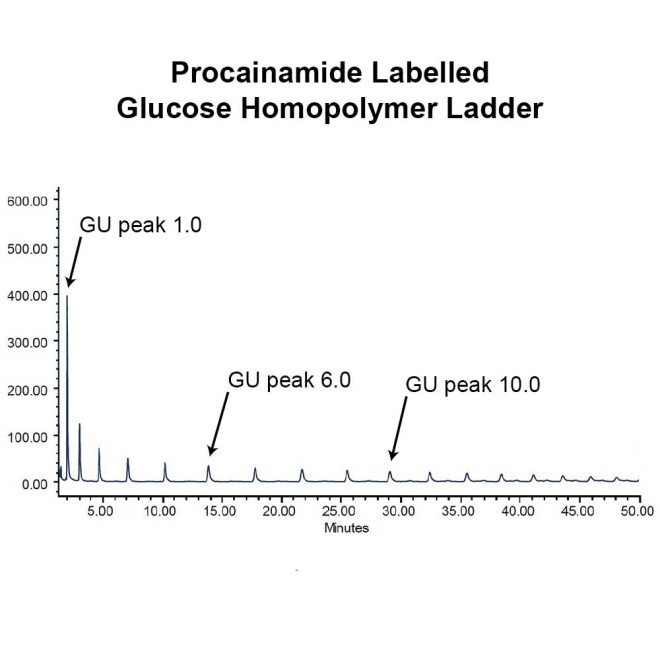Glucose homopolymer ladder (procainamide labelled)
Procainamide labelled glucose homopolymer ladder for use as a calibration standard for HPLC and MS analysis of glycans, 30 runs.
The ladder contains glucose homopolymer species from a degree of polymerization (DP) 1 to up to dp 22 (i.e. the glucose monomer GU1-PROC to 22 glucose units GU22-PROC).
Glucose homopolymer ladder was obtained by controlled acid hydrolysis of dextran then labelled by reductive amination at the reducing termini with the fluorescent glycan tag procainamide (PROC).
Product Specification
The glucose homopolymer ladder derived from digested wheat starch used as a standard for sizing of glycans. Amount supplied sufficient for 30 HPLC runs.
Sources: Derived from wheat starch
Form: Dry. Dried by centrifugal evaporation from an aqueous solution.
Amount:
CAB-GHP-30 30 runs 2-AB
CAA-GHP-30 30 runs 2-AA
CPROC-GHP-30 30 runs Procainamide
Purity: > 90% pure as assessed by a combination of HPLC
Storage: -20˚C both before and after dissolution. The products are stable for at least 5 years as supplied.
Shipping: The product can be shipped at ambient when dry. After dissolution, ship on dry ice.
Handling: Allow the unopened vial to reach ambient temperature and tap unopened on a solid surface to ensure that most of the lyophilized material is at the bottom of the vial. Gently remove the cap, add the desired volume of reconstitution medium, re-cap and mix thoroughly to bring all the oligosaccharide into solution. For maximal recovery of oligosaccharide, ensure that the cap lining is also rinsed and centrifuge the reconstituted vial briefly before use. Ensure that any glass, plasticware or solvents used are free of glycosidases and environmental carbohydrates. Minimise exposure to elevated temperatures or extremes of pH. High temperatures and low pH will cause desialylation. High pH will cause epimerisation of the reducing terminus GlcNAc.
Safety: The glucose homopolymer ladder is non-hazardous and has been purified from natural sources certified to be free of all hazardous material including pathogenic biological agents.
Use of Glucose Homopolymer Ladder as a system suitability standard
GHP ladder can be used as a system suitability standard to ensure that the liquid chromatography system is fit for purpose. The criteria which must be met are the following:
• Does the GHP profile match the profile shown in the CofA of the standard?
• Are the peaks symmetrical and well resolved? Do the peaks match the regular distribution pattern?
• Do at least two GHP profiles overlay?
Common problems encountered when assessing system suitability can include the following; asymmetrical peaks may indicate compromised column quality or column aging. Whilst, irregular elution patterns could result from insufficient equilibration and/or various issues with LC hardware components (i.e. pumps, buffer system, blockages etc.)
Use of Glucose Homopolymer Ladder as a reference standard
GHP ladder can also be used as a reference standard to assign GU values to peaks in the released glycan pool by comparison with the ladder. These GU values are reproducible and predictive as each monosaccharide in a glycan contributes a set increment to the GU value. This allows for primary assignment of structure by comparison of GU values for unknown glycans with glycan standards whose GU values are in databases or reported in the literature.
It is important to remember that the proposed identity of a glycan must be confirmed with further orthogonal structural analysis



